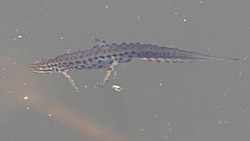Smooth newt facts for kids
Quick facts for kids Smooth Newt |
|
|---|---|
 |
|
| Conservation status | |
| Scientific classification | |
| Kingdom: | |
| Phylum: | |
| Class: | |
| Order: | |
| Family: | |
| Genus: |
Lissotriton
|
| Species: |
L. vulgaris
|
| Binomial name | |
| Lissotriton vulgaris (Linnaeus, 1758)
|
|
| Subspecies | |
|
L. vulgaris ampelensis |
|
| Synonyms | |
|
Triturus vulgaris |
|
The Smooth Newt is a small, fascinating amphibian that lives in many parts of Europe. It is also known as the Common Newt because it's one of the most widespread newt species. These creatures belong to a group of amphibians called Lissotriton. They can be found across Europe, including southern France and the Iberian Peninsula.
Contents
What is a Smooth Newt?
Smooth Newts are small amphibians, usually growing to about 8 to 11 centimeters (3 to 4 inches) long. They have smooth skin, which is how they got their name. Their skin can be different shades of brown or olive green.
Male and Female Differences
It's easy to tell male and female Smooth Newts apart, especially during their breeding season.
- Males: When it's time to breed, male Smooth Newts become very colorful. Their bellies turn bright orange with large dark spots. They also grow a wavy crest along their back and tail, which looks like a small fin. Their throat often has a spotted pattern.
- Females: Female Smooth Newts are usually less colorful. They are often a duller brown or olive color and do not grow a crest. Their bellies are also spotted, but the spots are smaller than those on males.
Their Skin and Spots
Both male and female Smooth Newts have spots on their throats and bellies. These spots are unique to each newt, almost like a fingerprint! The spots help scientists identify individual newts.
Where Do Smooth Newts Live?
Smooth Newts are found in many different habitats across Europe. They are often seen near water, as they need it for breeding.
Preferred Habitats
They love places with still or slow-moving water. This includes:
- Ponds
- Lakes
- Dithes
- Slow streams
They prefer water bodies that have lots of plants but no fish. Fish might eat their eggs or young. Outside of the breeding season, they live on land in damp places. You might find them under logs, stones, or in leaf litter.
What Do Smooth Newts Eat?
Smooth Newts are carnivores, meaning they eat other small creatures. Their diet changes depending on whether they are in water or on land.
Diet in Water
When they are in the water, Smooth Newts eat:
- Small insects and their larvae
- Water fleas
- Tadpoles
- Snail eggs
Diet on Land
When they are on land, they hunt for:
- Worms
- Slugs
- Spiders
- Small insects
They use their sticky tongues to catch their prey.
Life Cycle of a Smooth Newt
The life cycle of a Smooth Newt is a fascinating journey from water to land and back again. It involves several stages, starting with eggs and ending with an adult newt.
Eggs and Larvae
In spring, adult newts return to the water to breed. The female lays her eggs one by one on aquatic plants. She carefully folds a leaf around each egg to protect it. After about two to three weeks, tiny larvae hatch from the eggs. These larvae look a bit like miniature fish with feathery gills on the sides of their heads. They breathe underwater using these gills.
Metamorphosis
The larvae spend about two to three months in the water. During this time, they grow and develop. They slowly lose their gills and grow lungs, preparing for life on land. This change is called metamorphosis. Once they are ready, they leave the water.
Efts and Adults
Young newts that have just left the water are called efts. Efts live on land for one to three years. They are usually a duller color than adults. After this time, they become mature adults and return to the water to breed themselves. Smooth Newts can live for up to 6 years in the wild.
Smooth Newts and Other Animals
Smooth Newts play a role in their ecosystem, both as predators and as prey.
Predators
Even though they are small, Smooth Newts have some natural enemies. These can include:
- Birds, like herons
- Fish (if they are in water with fish)
- Snakes, such as the Grass snake
- Larger amphibians
When threatened, newts can release a milky substance from their skin that tastes bad to predators.
How to Help Smooth Newts
Smooth Newts are generally common, but their habitats can be threatened by pollution or loss of ponds.
Protecting Their Homes
You can help Smooth Newts by:
- Keeping local ponds clean and free of litter.
- Not using harmful chemicals in your garden that could wash into water.
- Creating a small pond in your garden, if possible, to provide a safe home for them.
- Learning more about amphibians and sharing what you know with others!
Images for kids
-
The cloaca is swollen in breeding males.
-
Well-developed larva shortly before metamorphosis
-
Two juveniles (efts) after the transition to land
-
Grass snake eating a smooth newt
See also
 In Spanish: Tritón común para niños
In Spanish: Tritón común para niños









